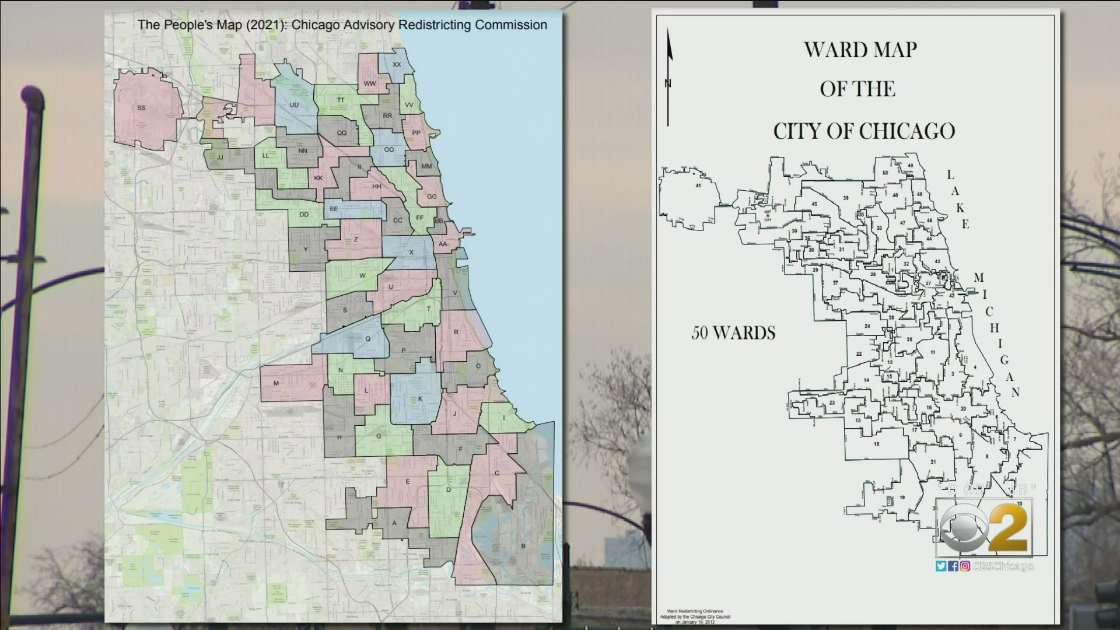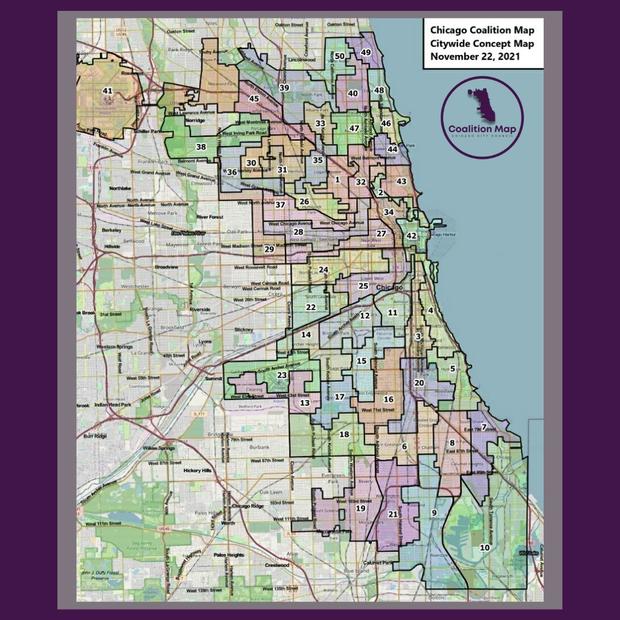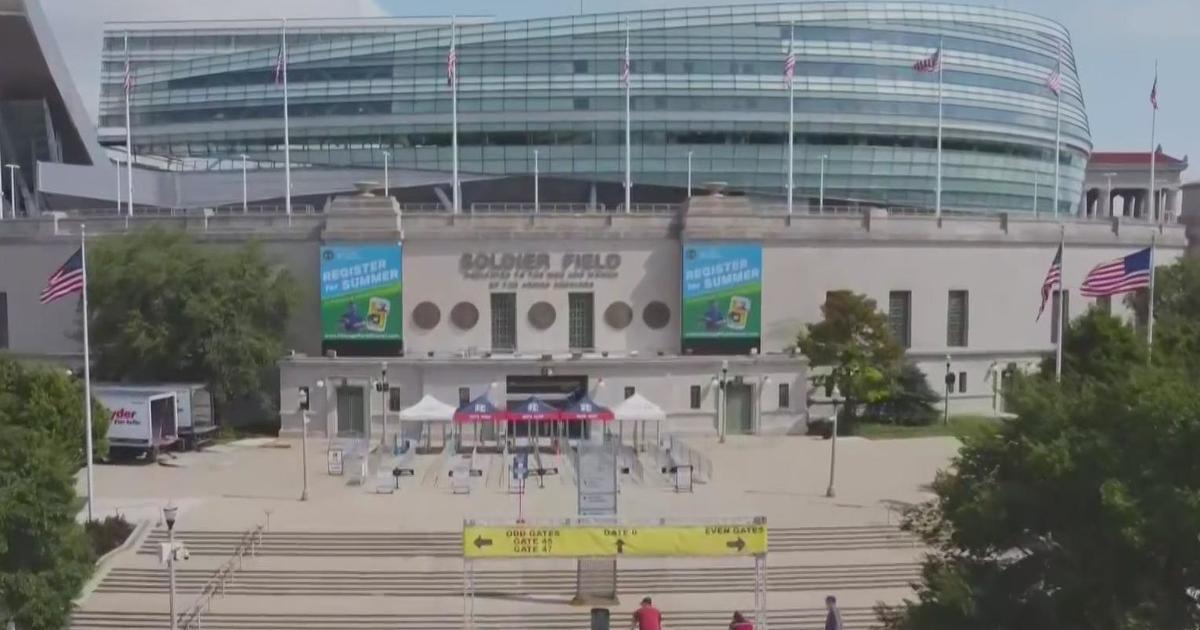Rules Committee Chair Unveils Chicago Ward Map Proposal After Canceling Potential Showdown Vote By City Council
by Todd Feurer, CBS Chicago web producer
CHICAGO (CBS) -- After keeping it under wraps for weeks, City Council Rules Committee Chair Ald. Michelle Harris (8th) on Wednesday unveiled her committee's proposal for a new map of the city's 50 wards, after calling off a potential showdown vote during a special meeting of the City Council.
Harris said the Rules Committee will host two hearings on the proposed map next week, before recessing for the holidays, and then hold further public hearings in January.
"To promote transparency, and to ensure that everyone has access to the redistricting process, I will chair Rules Committee meetings over the coming weeks and months to review the map, and discuss proposed changes," Harris said.
With no vote on a map on Wednesday, the City Council will miss a Dec. 1 deadline to pass a new map of all 50 wards based on 2020 Census data, opening the door to having two or more maps placed on the ballot next year for voters to decide.
The City Council's Latino Caucus has drawn up its own competing map, and has demanded any new ward map include at least 15 Hispanic-majority wards, based on the city's growing Latino population. Their map would include 15 majority-Latino wards, 16 majority-Black wards (down from the current 18), and the city's first majority-Asian ward.
However, the Black Caucus has insisted on at least 17 majority-African-American wards, and has said there should be only 14 Hispanic-majority wards, as well as the city's first majority-Asian ward.
It was not immediately clear if the Rules Committee's map meets either the Black Caucus' demand for 17 Black wards or the Latino Caucus' demand for 15 Hispanic wards.
While the Latino Caucus released its proposed map in early November, it wasn't until Wednesday that the Rules Committee proposal had been made public.
At a City Hall press conference before Wednesday's special City Council meeting, Ald. Carlos Ramirez-Rosa (35th) said he was happy to hear the vote on the Rules Committee's map had been called off.
"I guess they realized that it was very bad look to try and continue with the same old-school tired politics, but it's time for them to show us their map. It's time for us to be able to sit down, and negotiate, and reach a compromise. We cannot accept a map that disenfranchises Black and Latino communities. We cannot accept a map that slices and dices communities. We cannot accept a map that puts the political interests of a connected few before the interests of our neighborhoods," he said.
Ald. Gilbert Villegas (36th), who chairs the Latino Caucus, has repeatedly called the Rules Committee's map-making process the "least transparent ever."
"We cannot and will not vote on a map that we haven't seen. It's preposterous, but unfortunately these kinds of tactics are all too familiar. The Chicago machine of decades past is gone, but its vestiges still remain and threaten to hold us back," Villegas said.
Mayor Lori Lightfoot is in Washington, D.C., and has been hands-off with the remapping process. Despite her absence from Wednesday's council meeting, aldermen have not criticized her lack of involvement in the process so far.
"We can handle this ourselves," said Ald. Raymond Lopez (15th), one of the mayor's harshest critics. "This council has the ability to act without its mayor present, and while I can't remember a time the mayor not being here for something so important, personally, I have faith in my colleagues to get the job done one way or another."
Members of the Latino Caucus on Wednesday said they hope the move to call off the vote on the Rules Committee's map means both sides will have real negotiations in an effort to broker compromise, and avoid putting the decision on a new ward map up to a voter referendum.
"We do not want to have to go to a referendum, but if need be we're prepared to do so," Ramirez-Rosa said.
A referendum can be avoided if at least 41 aldermen vote to approve a new ward map. If a map is not approved by the council, or is approved with fewer than 41 votes, any 10 aldermen who voted against the council-approved map can file a petition to put a proposed map on the ballot during next year's primary election.
As CBS 2 Political Investigator Dana Kozlov reported Tuesday night, many Chicago communities are hoping the new map gives them more unity – rather than leaving their neighborhoods split between oddly-shaped wards each under the jurisdiction of a different alderman.
At Ainslie Street and Central Park in Albany Park, walking from the 35th Ward to the 33rd Ward or the 39th Ward involves a distance of a matter of feet. Three wards splitting up one neighborhood equals fragmented representation in City Hall for residents. A new map could change that.
But here is the problem – no one knows what the new ward map will look like. Less than 24 hours before aldermen are mandated by law to vote on that redrawn map, it is still cloaked in secrecy.
Some watchdogs say that all amounts to City Hall business as usual.
"They have been doing it essentially in a back room with the doors closed, and not a whole lot of sunlight or transparency," said Madeleine Doubek, executive director of Change Illinois.
Doubek said that should concern everyone who lives in the Windy City – an appropriate use of the moniker in this case.
"What they're doing is essentially rigging the system to favor incumbents and keep themselves in office," she said.
It is a time-honored practice in Chicago, despite campaign promises from Mayor Lori Lightfoot that it would be different this time around.
"We're terribly disappointed," Doubek said.
Change Illinois sent a letter to Mayor Lightfoot on Tuesday expressing those concerns. The group spent months working with the public on what they call a People's Map, which keeps most neighborhoods in one ward instead of splintering them.
The proposed People's Map and the current map can be seen side by side below.

Follow these links for a closer look at the current map and the proposed People's Map.
"There are communities like Englewood, like Logan Square, like Austin, and many others – Back of the Yards – that have been splintered and split up historically," Doubek said.
Chinatown is also one of those communities – in fact, it has never been encompassed in just one ward, despite a decades-long fight.
"Our whole drive behind making an Asian American majority ward is to ensure that the Asian American voice is heard in City Council," said Justin Sia of Asian Americans Advancing Justice Chicago.
Sia said they have gotten promises it will happen this time. If not, they will go to court.
But for those wondering why they should care, Doubek says neighborhoods splintered along several wards means confusion for people trying to get city help.
"it's makes it impossible for you to understand who you're supposed to reach, and how you're supposed to get government to respond to you," she said.
Splintered neighborhoods also undermine the power of community groups and organizations.





